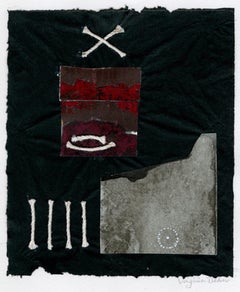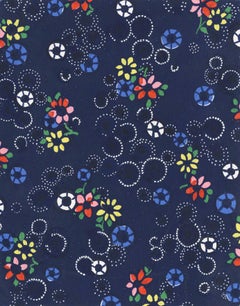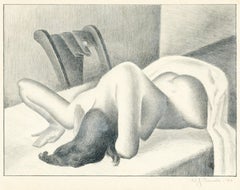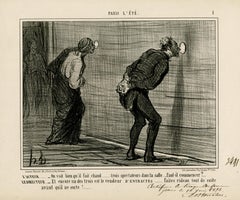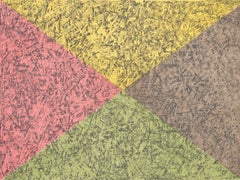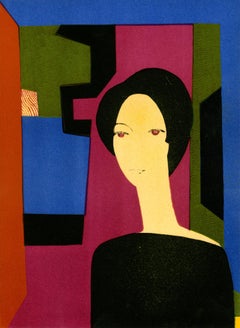Ohio - Art
to
20
932
381
300
151
274
Overall Width
to
Overall Height
to
55
198
1,236
547
54
57
144
122
75
106
178
160
143
57
36
436
317
307
117
54
38
28
25
22
15
9
7
1
959
798
130
572
275
198
196
141
116
101
81
80
80
76
64
54
52
49
44
37
35
30
29
793
283
276
215
215
94
60
57
47
47
520
160
233,653
151,154
Item Ships From: Ohio
Untitled
By Virginia Dehn
Located in Fairlawn, OH
Untitled
Mixed media with collage elements on paper, c. 1990's
Signed by the artist in pencil lower right (see photo)
Condition: Excellent
Image size: 7 1/16 x 6 inches
Support sheet size: 10 9/16 x 8 3/8 inches
Provenance: Estate of the artist
Dehn Heirs
Virginia Dehn
From Wikipedia, the free encyclopedia
Virginia Dehn
Virginia Dehn in her studio in Santa Fe
Virginia Dehn (née Engleman) (October 26, 1922 – July 28, 2005) was an American painter and printmaker. Her work was known for its interpretation of natural themes in almost abstract forms. She exhibited in shows and galleries throughout the U.S. Her paintings are included in many public collections.
Life
Dehn was born in Nevada, Missouri on October 26, 1922.] Raised in Hamden, Connecticut, she studied at Stephens College in Columbia, Missouri before moving to New York City. She met the artist Adolf Dehn while working at the Art Students League. They married in November 1947. The two artists worked side by side for many years, part of a group of artists who influenced the history of 20th century American art. Their Chelsea brownstone was a place where artists, writers, and intellectuals often gathered.
Early career
Virginia Dehn studied art at Stephens College in Missouri before continuing her art education at the Traphagen School of Design, and, later, the Art Students League, both located in New York City. In the mid-1940s while working at the Associated American Artists gallery, she met lithographer and watercolorist Adolf Dehn. Adolf was older than Virginia, and he already enjoyed a successful career as an artist. The two were married in 1947 in a private ceremony at Virginia's parents house in Wallingford, Connecticut.
Virginia and Adolf Dehn
The Dehns lived in a Chelsea brownstone on West 21st Street where they worked side by side. They often hosted gatherings of other influential artists and intellectuals of the 20th century. Among their closest friends were sculptor Federico Castellón and his wife Hilda; writer Sidney Alexander and his wife Frances; artists Sally and Milton Avery; Ferol and Bill Smith, also an artist; and Lily and Georges Schreiber, an artist and writer. Bob Steed and his wife Gittel, an anthropologist, were also good friends of the Dehns. According to friend Gretchen Marple Pracht, "Virginia was a glamorous and sophisticated hostess who welcomed visitors to their home and always invited a diverse crowd of guests..." Despite their active social life, the two were disciplined artists, working at their easels nearly daily and taking Saturdays to visit galleries and view new work.
The Dehns made annual trips to France to work on lithographs at the Atelier Desjobert in Paris. Virginia used a bamboo pen to draw directly on the stone for her lithographs, which often depicted trees or still lifes. The Dehns' other travels included visits to Key West, Colorado, Mexico, and countries such as Greece, Haiti, Afghanistan, and India.
Dehn's style of art differend greatly from that of her husband, though the two sometimes exhibited together. A friend of the couple remarked, "Adolf paints landscapes; Virginia paints inscapes." Virginia Dehn generally painted an interior vision based on her feelings for a subject, rather than a literal rendition of it.] Many of her paintings consist of several layers, with earlier layers showing through. She found inspiration in the Abstract Expressionism movement that dominated the New York and Paris art scenes in the 1950s. Some of her favorite artists included Adolf Gottileb, Rothko, William Baziotes, Pomodoro, and Antonio Tapies.
Dehn most often worked with bold, vibrant colors in large formats. Her subjects were not literal, but intuitive. She learned new techniques of lithography from her husband Adolf, and did her own prints. Texture was very important to her in her work. Her art was influenced by a variety of sources. In the late 1960s she came across a book that included photographs of organic patterns of life as revealed under a microscope. These images inspired her to change the direction of some of her paintings. Other influences on Dehn's art came from ancient and traditional arts of various cultures throughout the world, including Persian miniatures, illuminated manuscripts, Dutch still life painting, Asian art, ancient Egyptian artifacts...
Category
1990s Contemporary Ohio - Art
Materials
Other Medium
Untitled Fabric Design
By Arthur Litt
Located in Fairlawn, OH
Untitled Fabric Design
Gouache on paper, 1920-1935
Signed with the Atelier Stamp verso (see photo)
Numbered with the Atelier Litt Archive number verso
(see photo)
Condition: E...
Category
1930s Abstract Ohio - Art
Materials
Gouache
Untitled (Reclining nude, face down)
Located in Fairlawn, OH
Untitled (Reclining nude, face down)
Lithograph, 1944
Signed and dated lower right in pencil
Image size: 8 13/16 x 11 7/8 inches
Sheet Size: 11 1/8 x 18 3/4 inches
Condition: Aging ...
Category
1940s Art Deco Ohio - Art
Materials
Lithograph
L'ACTEUR . . . . - On voit bien qu'il fait chaud . . . . . . . trois spectateurs
By Honoré Daumier
Located in Fairlawn, OH
L'ACTEUR . . . . - On voit bien qu'il fait chaud . . . . . . . trois spectateurs dans la salle ..... faut-il commencer ? . . . .
LE DIRECTEUR .- Et encore un des trois est le vendeu...
Category
1850s Romantic Ohio - Art
Materials
Lithograph
The Season's Encounter
By Mark Tobey
Located in Fairlawn, OH
The Season's Encounter
Signed, dated and numbered in the lower margin
Edition: 20 (16/20)
Signed, dated and numbered in the lower margin
Condition: Mint, flawless
Image: 17 3/4 x 13 ...
Category
1960s Abstract Ohio - Art
Materials
Lithograph
Untitled
By Andre Minaux
Located in Fairlawn, OH
Unsigned
Edition: Large edition as published and bound into the catalog raisonne of the artist's lithographs
From: Minaux Lithographe
Published by Leon Amiel, Paris
Printed by Fe...
Category
1970s Ohio - Art
Materials
Lithograph
Fishing Village, Sicily, Dystopian Surrealist Landscape, Cleveland School Artist
By John Teyral
Located in Beachwood, OH
John Teyral (American, 1912-1999)
Fishing Village, Sicily, c. 1965
Oil on canvas
Signed upper right
37.5 x 44.5 inches, framed
John Teyral was one of Cleveland's most acclaimed arti...
Category
1960s Ohio - Art
Materials
Oil
untitled
By Peter Marks
Located in Fairlawn, OH
Untitled
Collage made of foil, golf leaf and marbled book papers, c. 2004
Unsigned, from the Estate of the artist.
Image size: 8 5/8 x 10 inches
Sheet size: 14 x 17 inches
Peter Marks (1935 -2010)
Peter Marks was born in New York City on January 18, 1935. A lifetime New Yorker, Marks graduated from the High School of Music and Art in 1952 and Amherst College in 1956.
After a brief stint as a graphic designer in publishing, Marks became a private art dealer and opened his gallery Peter Marks Works of Art, Inc. in 1960. During this time he specialized in the sale of Southeast Asian and Islamic antiquities and made many contributions to the field both as a dealer and an advocate of his profession. Above all, Marks was motivated by a strong desire to find great art and make it available to large audiences.
After retiring from art dealing in 2002, Marks transformed his Manhattan gallery space into a studio where he drew prolifically and painted large non-objective canvasses. This time in his studio was a happy one for Marks, who viewed this period of his life not as retirement, but rather fulfillment, a fact that is confirmed by passionate artistic output in the years leading up to his passing in 2010.
In 2012, Thomas French...
Category
Early 2000s Abstract Ohio - Art
Materials
Mixed Media
Brooklyn Waterfront
By Adolf Arthur Dehn
Located in Fairlawn, OH
Brooklyn Waterfront
Lithograph, 1931
Signed, titled, and dated in pencil by the artist
Edition: Undetermined (very small), plus artist's proofs
Printed by Meister Schulz, Berlin
Provenance:
Estate of the artist
Virginia Dehn, the artist's widow
Dehn Quests
Bibliography:
Lumsdaine and O'Sullivan 152
Illustrated: Adams, The Sensuous Life of Adolf Dehn, Fig. 9.14, page 213 (This impression)
Adolf Dehn, American Watercolorist and Printmaker, 1895-1968
Adolf Dehn was an artist who achieved extraordinary artistic heights, but in a very particular artistic sphere—not so much in oil painting as in watercolor and lithography. Long recognized as a master by serious print collectors, he is gradually gaining recognition as a notable and influential figure in the overall history of American art.
In the 19th century, with the invention of the rotary press, which made possible enormous print runs, and the development of the popular, mass-market magazines, newspaper and magazine illustration developed into an artistic realm of its own, often surprisingly divorced from the world of museums and art exhibitions, and today remains surprisingly overlooked by most art historians. Dehn in many regards was an outgrowth of this world, although in an unusual way, since as a young man he produced most of his illustrative work not for popular magazines, such as The Saturday Evening Post, but rather for radical journals, such as The Masses or The Liberator, or artistic “little magazines” such as The Dial. This background established the foundation of his outlook, and led later to his unique and distinctive contribution to American graphic art.
If there’s a distinctive quality to his work, it was his skill in introducing unusual tonal and textural effects into his work, particularly in printmaking but also in watercolor. Jackson Pollock seems to have been one of many notable artists who were influenced by his techniques.
Early Years, 1895-1922
For an artist largely remembered for scenes of Vienna and Paris, Adolf Dehn’s background was a surprising one. Born in Waterville, Minnesota, on November 22, 1895, Dehn was the descendent of farmers who had emigrated from Germany and homesteaded in the region, initially in a one-room log cabin with a dirt floor. Adolf’s father, Arthur Clark Dehn, was a hunter and trapper who took pride that he had no boss but himself, and who had little use for art. Indeed, during Adolf’s boyhood the walls of his bedroom and the space under his bed were filled with the pelts of mink, muskrats and skunks that his father had killed, skinned and stretched on drying boards. It was Adolf’s mother, Emilie Haas Dehn, a faithful member of the German Lutheran Evangelical Church, who encouraged his interest in art, which became apparent early in childhood. Both parents were ardent socialists, and supporters of Eugene Debs...
Category
1920s American Modern Ohio - Art
Materials
Lithograph
Page de Croquis: Tetes de Antilops
By Joseph Hecht
Located in Fairlawn, OH
Signed in pencil lower right recto
Provenance:
Elizabeth Carroll Shearer (1924-2014), Chesterland, Ohio, former President and Trustee of the Print Club of Cleveland which is an affiliate of the Cleveland Museum of Art. Her collectors mark of initials and a Sealyham Terrier...
Category
Early 20th Century Ohio - Art
Materials
Graphite
Untitled Abstraction
By John von Wicht
Located in Fairlawn, OH
Untitled Abstrraction
Gouache, watercolor and pigments on paper, c. 1960
Signed lower right in pencil (see photo)
Image: 17 x 22 inches
Sheet: 25 1/4 x 29 3/4 inches
Frame: 25 1/4 x ...
Category
1960s Abstract Expressionist Ohio - Art
Materials
Watercolor
Pappy (Study for Over and Above: Gorilla), Mid-Century Figurative Drawing
By Clarence Holbrook Carter
Located in Beachwood, OH
Clarence Holbrook Carter (American, 1904-2000)
Pappy (Study for Over and Above: Gorilla), c. 1973
Colored pencil on paper
Signed and dated lower left
7 x 7 inches
20.75 x 19 inches, framed
Clarence Holbrook Carter achieved a level of national artistic success that was nearly unprecedented among Cleveland School artists of his day, with representation by major New York dealers...
Category
1970s American Modern Ohio - Art
Materials
Color Pencil
Untitled
By Peter Marks
Located in Fairlawn, OH
Untitled
Acrylic with gold leaf on canvas, metallic foil and glitter paper collage mounted on paper, c. 2003-2004
Unsigned
Provenance: Estate of...
Category
Early 2000s Abstract Ohio - Art
Materials
Mixed Media
$600 Sale Price
50% Off
Untitled Fabric Design
By Arthur Litt
Located in Fairlawn, OH
Untitled Fabric Design
Gouache on paper, 1920-1935
Signed with the Atelier Stamp verso (see photo)
Numbered with the Atelier Litt Archive number verso
(see photo) No. 05535
...
Category
1930s Abstract Ohio - Art
Materials
Gouache
Side View Seated Female Nude
By Frank Duveneck
Located in Fairlawn, OH
Side View Seated Female Nude
Graphite on paper, c. 1890's
Unsigned
Provenance:
Rookwood Pottery Factory Collection, Cincinnati
Spanierman Gallery, New York (label)
Drawings from the...
Category
1890s American Impressionist Ohio - Art
Materials
Graphite
Bathing at Long Branch-“Oh, Ain’t it Cold”
By Winslow Homer
Located in Fairlawn, OH
Bathing at Long Branch-“Oh, Ain’t it Cold”
Wood engraving, 1871
Signed in the block with the artist's initials "WH", see photo
Published in: Every Saturday, Aug. 16, 1871
Condition: ...
Category
1870s Hudson River School Ohio - Art
Materials
Woodcut
JAMES BROWN Moroccan VI - 1993 Bronze abstract Sculpture of Head - small edition
By James Brown
Located in Rancho Santa Fe, CA
From the signed and numbered edition of 6.
James Brown's artwork can be found on the collections of:
Centre National d'Art et de Culture Georges Pompidou, Paris
Musee Cantini, Marse...
Category
1990s Contemporary Ohio - Art
Materials
Bronze
Flower Studies
By Mary Spain
Located in Fairlawn, OH
Unsigned
Graphite and colored pencils on laid paper
Category
Mid-20th Century Surrealist Ohio - Art
Materials
Color Pencil, Graphite
Original Ronald Shap figure drawing, signed
Located in Columbus, OH
Original gouache and ink nude figure drawing by celebrated, twentieth-century California impressionist landscape painter, Ronald Shap. Torso and buttocks of man with arm raised in wa...
Category
1980s Contemporary Ohio - Art
Materials
Ink, Gouache
Head of a Deco Woman (recto) Standing Male Model (verso)
By Paul H. Winchell
Located in Fairlawn, OH
Head of a Deco Woman (recto) Standing Male Model (verso)
Graphite on paper, 1925
Signed with the artist's initials "PW" and dated 1925
Created while the artist was studying at the Art Institute of Chicago in 1925.
This is a preliminary drawing to a series of class assignments.
From a sketch book
Image/Sheet size: 7 5/8 x 4 7/8 inches
Condition: Excellent Slight syrface dirt
Provenance: Estate of the Artist
Winchell Heirs
Paul H. Winchell (1903 – 1971) was a printmaker, illustrator, teacher, and gilder according to Crump, 2009 (Minnesota Prints and Printmakers, 1900- 1945, Minnesota Historical Society Press). He was the son of Mrs. Looman Winchell of Shepherd Rd as noted in a 1937 newspaper article (Painsville, O. Telegraph). Winchell grew up in North Perry, Ohio and then studied and worked as an instructor at the Art Institute of Chicago. He studied with Leon Kroll (1884 – 1974), Boris...
Category
1920s Art Deco Ohio - Art
Materials
Graphite
Le Tasse de The (The Cup of Tea)
By Manuel Robbe
Located in Fairlawn, OH
Le Tasse de The (The Cup of Tea)
Color aquatint and etching, c. 1906
Signed in pencil in the image (see photo)
Edition: c. 100
Reference: Merrill Chase, Volume 1, No. 85
Condition: F...
Category
Early 1900s Art Nouveau Ohio - Art
Materials
Aquatint
Morphos
By Hunt Slonem
Located in Cleveland, OH
This is an original work by world famous artist Hunt Slonem.
Category
2010s Modern Ohio - Art
Materials
Oil
$28,000
Isadora Duncan
By Abraham Walkowitz
Located in Fairlawn, OH
Isadora Duncan
Graphite with grey wash on paper mounted to cardstock
Signed and dated in pencil lower right (see photo)
Provenance: Charlotte Bergman, f...
Category
1910s American Modern Ohio - Art
Materials
Graphite
Centered Rings
By Julian Stanczak
Located in Fairlawn, OH
Centered Rings
Screen print, 1971
Signed and numbered in pencil
From: Twelve Progressions
Commissioned by Martha Jackson Graphics
Printer: Domberger, Stuttgart, Germany
Their drystam...
Category
1970s Op Art Ohio - Art
Materials
Screen
Standing Male Nude
By Frank Duveneck
Located in Fairlawn, OH
Standing Male Nude
Graphite on wove paper, c. 1890's
Unsigned
Sheet size: 9 5/16 x 6 inches
Provenance:
Rookwood Pottery Factory Collection, Cincinnati
Ira Spanierman, New York (labe...
Category
1890s Ohio - Art
Materials
Graphite
Composition rouge orangé
By Arthur Luiz Piza
Located in Fairlawn, OH
Composition rouge orangé
Etching, Aquatint, and Engraving, 1990
Signed "Piza" lower right corner (see photo)
Edition: 99
Numbered 96/99 lower left corner (see photo)
Publisher blinds...
Category
1990s French School Ohio - Art
Materials
Aquatint
WO RO SI IA ZIN Russian Soldier with His Family
Located in Fairlawn, OH
WO RO SI IA ZIN Russian Soldier with His Family
Color woodcut, 1861 2nd month
Signed upper left (see photo)
Titled upper right in black cartouche (see photo)
Format: oban
Style: Yokohama-e
Publisherr: Sagamiya Tokichi (Marks #435) active 1955-1866
Metropolitan Museum of Art in New York, has an impression of this image
RARE
Condition: with usual aging
Image size: 13 7/8 x 9 3/8 inches
Rebecca Salter in her Japanese Popular Prints... on page 18 gives a different take on the situation that Yoshifuji found himself in.
"A giant of the period, however, was Utagawa Kuniyoshi (1797-861). Although best known for warrior prints which reflected the militaristic undercurrents of the time, he was also responsible for some of the most light-heartend and humorous works in this book. His followers in the Utagawa school, Utagawa Yoshitsuya...
Category
1860s Other Art Style Ohio - Art
Materials
Woodcut
Juniper, Lake Tenaya
By Edward Weston
Located in Fairlawn, OH
Juniper, Lake Tenaya
Gelatin silver print, 1937
Unsigned
Edward Weston Estate stamp verso (see photo)
A lifetime printing by Brett Weston, supervised by his father Edward, printed in...
Category
1930s American Modern Ohio - Art
Materials
Silver Gelatin
Trees, Will Roger's Park
Located in Columbus, OH
Original gouache painting by celebrated, twentieth-century California landscape painter, Ronald Shap. Sketch of trees in Will Roger’s Park in Los Angeles in colors of blue and green....
Category
20th Century Contemporary Ohio - Art
Materials
Watercolor, Gouache
Jazz Singer
By Stephen Longstreet
Located in Fairlawn, OH
Jazz Singer
Mixed media 3 dimensional collage sculpture, 1975
Although dated 1975, this work may well have been done in the 1980s. Longstreet dated his works for the period they represented, not necessarily the date of actual execution.
Dimensions: 41 x 18 1/4 x 1 1/4 inches
Signed on the reverse (see photo)
Artist's address sticker on reverse (see photo)
Provenance: Acquired from the artist by his friend and patron, Joseph M. Erdelac, Cleveland
Stephen Longstreet (1907-2002)
At the website, the artist’s own grandchildren attempt to fathom the real life and nature of Stephen Longstreet, prolific author, artist, screenplay writer, and jazz aficionado.
Born Chauncy Weiner (sometimes spelled Wiener) in New York City in 1907, Longstreet reinvented himself on a regular basis. Changing his name first to “Henry,” then “Henri,” he started his career as a commercial artist for a department store. In various public biographies he claimed to have studied in New York, London, and Paris, and said he was a student of cartoonist Ralph Barton (1891-1931). Facts that can be documented are that he was art editor for Golfer and Sportsman magazines, and was a contributor to various other magazines including The New Yorker, Saturday Evening Post, Colliers, Life, and Hooey, among others. He wrote sketches for NBC radio and the Rudy Vallee Show.
In the 1930s, Longstreet worked and wrote under the names Thomas Burton, David Ormsbee, and Paul Haggard...
Category
1970s American Modern Ohio - Art
Materials
Mixed Media
Untitled (Seated Nude)
By Mary Ingebrand-Pohlad
Located in Fairlawn, OH
Signed in ink: Ingebrand
Drawings by the artist are in the collections of the Swope Art Museum, Terre Haute, IN and the Minnesota Museum of American Art...
Category
Ohio - Art
Materials
Ink
Untitled
By Laddie John Dill
Located in Fairlawn, OH
Untitled
Watercolor on paper, c. 1971
Unsigned
From the collection of Ileana Sonnabend (1914-2007)
Laddie John Dill, a Los Angeles artist, had his first solo exhibition in New York C...
Category
1970s Abstract Ohio - Art
Materials
Watercolor
Coquette
By Victor Max Ninon
Located in Fairlawn, OH
Coquette
Pochoir (silk screen) printed in colors, c. 1923-1925
Signed by the artist in pencil lower right; numbered in ink on the image, (see photo)
Edition: 250 (100/250) in pencil in image (see photo)
Image size: 10-1/2 x 12-3/4"
The artist won a gold medal in Paris in 1925 for his porchoirs
Victor Max Ninon (Vittorio Accornero de Testa, Italian, 1896-1982)
Biography
Vittorio Accornero de Testa was born in Casale Monferrato in 1896. He completed his first studies at the "Leardi" institute, but was forced to interrupt them due to the war events of the First World War . At 19 he was second lieutenant of the Alpine troops and in 1916 he took one of the first pilot's licenses. During the war he knows the bitterness of shooting down in air combat (for which he is decorated), but also the good fortune to stay alive, albeit with a disability. His art blossomed in the postwar period, first signing his works simply Ninon and then, probably at the suggestion of a French publisher, under the pseudonym of "Victor Max Ninon" (Victor and Max indicate strength and masculinity, Ninon boyhood) .In 1919 and 1924 he made illustrations for theGiornalino della Domenica , also together with his first wife Edina Altara , for Ardita and La Lettura . In 1923 he won the cover competition organized by the magazine El Hogar of Buenos Aires and in 1925 with his pochoirs he imposed himself in Paris at the international exhibition of modern decorative and industrial arts , obtaining a gold medal. In the same year he made two covers for the US magazine The Smart Set . In the 1920s he made numerous series of art deco style postcards for the Milanese publishing house Degami . On June 4, 1929, aGenoa embarks on the Conte Grande together with his wife Edina Altara , for New York . The two stayed in the American metropolis for a few months: in this period Accornero worked on the creation of theatrical sets and created some covers for Country Life magazine . Accornero gets awards and prizes, but the great economic crisis of the time and the nostalgia for Italy convince the two to return to their homeland, where they resume their activity as illustrators.
In 1934 Accornero moved to Milan, separated amicably from his wife and continued to dedicate himself to the illustration of children's books, abandoning the pseudonym Victor Max Ninon. It illustrates about 60 books, from the fables of Andersen , Perrault and Grimm , to the tales of Poe , as well as the famous Pinocchio and Cuore published by Mondadori, Mursia, Hoepli, Martello. Several books illustrated by Accornero have been published in French, Spanish, German and English. In addition to the periodicals already mentioned, he collaborates on the first edition of the Encyclopedia of Boys , Mondadori, and with the Italian magazines Lidel , Il Secolo XX, The Italian Illustration , Fantasies of Italy , The Woman , Cordelia , For You Lady , Grace , Metropolis , La Domenica del Corriere , The Corriere dei Piccoli .
In 1936 enters the world of cinema, creating sets and costumes for Wedding Vagabonde of Guido Brignone and The White Squadron of Augustus Genina . From 1935 to 1950 he also devoted himself to the theater, taking care of sets and costumes for numerous operettas, ballets and performances at the Scala in Milan and for the Milanese theaters Manzoni, Lirico and Olympia. Stages Marcello di Giordano, Nina pazza d'amore by Paisiello, I cantori di Nurimberga by Wagner, La Bohème by Puccini and other works. For this activity he is also cited in the Theater encyclopedia.
In the 1940s and 1950s he wrote and illustrated six books for children for Mondadori: Tomaso (1944), Giacomino (1949), Tomaso Cacciatore (1950), Zio Stefano (1950), In Campagna che delizia! (1953), Tomaso, dear Tomaso (1955). His illustrations of Perrault's Tales published in those years by Hoepli are famous.
His art in the fifties evolves towards hyperrealism . There are many personal exhibitions in Italy and abroad, including those at the Gallerie Gussoni (1959) and Bolzani (1963 and 1966) in Milan and Walcheturm (1962) in Zurich. Eminent critics praise his work, from Orio Vergani to Enrico Piceni, from Reto Roedel to De Chirico himself. On the Domenica del Corriere , the journalist, writer and painter Dino Buzzati...
Category
1920s Art Deco Ohio - Art
Materials
Stencil
Nuns in My Studio, Self-Portrait, 20th Century Italian-American Artist
By Louis Bosa
Located in Beachwood, OH
Louis Bosa (American, 1905-1981)
Nuns in My Studio
Oil on canvas
Signed lower right
10 x 14 inches
15.5 x 19.5 inches, framed
Born in Codroipo, a small village only a few miles from...
Category
Late 20th Century Ohio - Art
Materials
Oil
Portrait of a Man Facing Left
By William Merritt Chase
Located in Fairlawn, OH
Portrait of a Man Facing Left
Monotype printed in brown ink, c. 1880-1914
Signed in ink lower left: Chase (see photo)
Provenance:
Helen Chase Storm (the artist's daughter)
Jackson Chase Storm (her son)
Chapellier Galleries (as agent)
James Bergquist, Boston
References And Exhibitions:
Exhibited at the Museum of Fine Arts, Boston and the Clark Art Institute, Williamstown, MA. (See MFA paperwork in photos)
Reference:
Ronald G. Pisano, Completed by D. Frederick Baker and Carolyn K. Lane, William Merritt Chase: Still Lifes, Interiors, Figures, Copies of Old Masters, and Drawings, Catalogue Raisonne, Vol. IV (New Haven and London: Yale University Press, 2010), Vol. 1, M. 8. (See photos of entry)
William Merritt Chase (1840-2016)
Born in Nineveh, Indiana Died New York, New York
In 1883 Chase was involved in the organization of an exhibition to help raise funds for a pedestal for the Statute of Liberty. The exhibition featured loans of three works by Manet and urban scenes by the Italian Impressionist Giuseppe de Nittis. Both artists influenced Chase's Impressionistic style that gave rise to a series of New York park scenes. It is also thought that he was influenced by John Singer Sargent's In the Luxembourg Gardens (1879) which was exhibited in New York at this time. Indeed, Chase had met Sargent in Europe in 1881, the two men becoming lifelong friends with Sargent painting Chase's portrait in 1902.
On another European trip in 1885, Chase met James McNeill Whistler in London. While Whistler had a reputation for being difficult, the two artists got along famously and agreed to paint one another's portrait. Eventually, however, Whistler's moods began to grate with Chase who wrote home stating "I really begin to feel that I never will get away from here". For his part, Whistler criticized Chase's finished portrait and, according to Hirshler, "complained about Chase for the rest of his life". While no record exists of Whistler's portrait of Chase; Chase's portrait of Whistler remains a well-known piece in his oeuvre.
In 1887 Chase married Alice Gerson, the daughter of the manager of a lithography company. Though some fifteen years his junior (Chase was 37), he had known Alice for some time through her family's devotion to the arts. The pair, who would enjoy a happy marriage with Alice in full support of her husband's career, settled initially in Brooklyn...
Category
1890s Impressionist Ohio - Art
Materials
Monoprint
Flower and Pot
Located in Fairlawn, OH
Flower and Pot
Color mezzotint, 1983
Signed, numbered, and dated in pencil
John Szoke Graphics blindstamp, lower right
Edition: 150 (100/150)
Image si...
Category
1980s Contemporary Ohio - Art
Materials
Mezzotint
Weathering II
Located in Dallas, TX
Layered torn paper collage
Category
2010s Abstract Ohio - Art
Materials
Paper, Mixed Media, Acrylic
Title Page-An Encampment in Ethiopia
By Francis Frith
Located in Fairlawn, OH
Title Page-An Encampment in Ethiopia
Original gold toned albumin photograph, c. 1862
Unsigned as is usual
From: Upper Egypt and Ethiopia, c. 1862, Vol 3, (36 plates)
Published by Wil...
Category
1860s Romantic Ohio - Art
Materials
Photographic Paper
Untitled (Abstraction)
By Charles Harris ( Beni Kosh )
Located in Fairlawn, OH
aka Beni Kosh
Untitled (Abstraction)
Watercolor on paper, 1970's
Unsigned
Ben Kosh Estate Stamp verso, No. 754
Condition: Very good
Sheet size: 10 5/8 x 14 9/16 inches
Provenance: Estate the Artist
Bingham & Vance, Shaker Heights...
Category
1970s Abstract Ohio - Art
Materials
Watercolor
Swan Baby, 19th Century Bronze & Marble Sculpture of Cherub Riding Swan
Located in Beachwood, OH
Auguste Moreau (French, 1834-1917)
Swan Baby, 19th Century
Bronze with reddish gold patination mounted on verdigris marble base
Signed on base
6 x 9.5 x 5 inches
Auguste Moreau was...
Category
19th Century Ohio - Art
Materials
Marble, Bronze
Untitled
By Virginia Dehn
Located in Fairlawn, OH
Signed by the artist in acrylic lower right
Provenance:
Estate of the Artist
Acrylic on paper
Category
20th Century Abstract Ohio - Art
Materials
Acrylic
Toro and Horse
By Ralston Crawford
Located in Fairlawn, OH
Toro and Horse
Lithograph, 1957
Signed and numbered in pencil by the artist.
Titled in pencil lower left.
Edition: 25 (24/25)
Printer: Ravel, Paris
Reference: Freeman L57.11
'Toro and Horse' was inspired by Spanish bullfighting...
Category
1950s Cubist Ohio - Art
Materials
Lithograph
Beaver Pond, Longs Peak, Rocky Mountain National Park Colorado Western Landscape
By Frank Wilcox
Located in Beachwood, OH
Frank Nelson Wilcox (American, 1887–1964)
Beaver Pond near Longs Peak, Rocky Mountain National Park, Colorado, c. 1950
Watercolor on Paper
19 x 24 inches
21 x 26 inches framed
Frank...
Category
1950s Ohio - Art
Materials
Watercolor
Canticle 3
By Hunt Slonem
Located in Cleveland, OH
Multicolor Butterflies, Blue Scored
Category
2010s Contemporary Ohio - Art
Materials
Oil
$35,500
Pulsar
By Roy Ahlgren
Located in Fairlawn, OH
11 value silkscreen print
Signed, dated, titled and numbered in pencil by the artist.
Edition of 150, plus 20 AP's as is here AP XV/XX.
Provenance:
Estate of the Artist
By dece...
Category
1980s Op Art Ohio - Art
Materials
Screen
untitled (Woman and Cat)
By Mary Spain
Located in Fairlawn, OH
Unsigned
Graphite on paper
Category
20th Century Surrealist Ohio - Art
Materials
Graphite
Impossible Solutions at The Fountain of Youth
Located in Fairlawn, OH
Impossible Solutions at The Fountain of Youth
Collage on paper, 1987
Signed with the artist's initials and datedlower left
Condition: Good, with the ...
Category
1980s Surrealist Ohio - Art
Materials
Paper
Quick Change
By Honore Guilbeau
Located in Fairlawn, OH
Quick Change
Watercolor on paper, 1930-1931
Signed lower right: Honore Guilbeau
Illustrated in American Art Review, August 2014, page 84 in an article by Dr. M...
Category
1930s American Modern Ohio - Art
Materials
Watercolor
Downstairs Influence, Painting, Oil on Canvas
By Matthew Dibble
Located in Yardley, PA
An aged yet still beautiful ornate building in Chicago, captured by photographer William Dey. Image is printed on Picture Rag museum-quality paper and measures 20" X 15" with white borders for a total overall measurement of 22" X 17". Signed & Numbered Limited Edition from the William Dey Signature Collection. This image has an "analog film" technique with the mixed addition of light leaks, a vintage film look...
Category
21st Century and Contemporary Abstract Ohio - Art
Materials
Oil
XXe Siecle-Hommage a Marc Chagall
By Marc Chagall
Located in Fairlawn, OH
XXe Siecle-Hommage a Marc Chagall
Color lithograph, 1969
Unsigned as issued by XXe Siecle
From: XXe Siecle, Volume, Special Issue Marc Chagall
Published by G. di San Lazzaro for A. M...
Category
1960s French School Ohio - Art
Materials
Lithograph
David Hostetler Carved Nickle Sculpture Silver Modern Female Bust 1980s
By David Hostetler
Located in Nantucket, MA
Bust of Quiet Woman is cast nickel. The surface was then re-carved to accent each of the original marks in the wood. This is the only Hostetler sculpture ever cast in nickel and the ...
Category
1980s Abstract Ohio - Art
Materials
Metal
$7,600 Sale Price
20% Off
Xylon 21 Naoko Matsubara USA
Located in Fairlawn, OH
Xylon 21 Naoko Matsubara USA
Woodcuts, two which are printed in color, 1970
2 of the 5 woodcuts signed in pencil (see photos)
Five original woodcuts, two of which are signed in penci...
Category
1970s Abstract Ohio - Art
Materials
Woodcut
Three to Compare
By Julian Stanczak
Located in Fairlawn, OH
Three to Compare
From: Twelve Progressions
Signed and numbered in pencil
Commissioned by Martha Jackson Graphics
Printer: Domberger, Stuttgart, Germany
Their drystamp lower right cor...
Category
1970s Op Art Ohio - Art
Materials
Screen
Sisters by Frederick Hart
By Frederick Hart
Located in Cleveland, OH
Frederick Hart is America's greatest figurative sculptor. Not only did he create works of great beauty and gravitas, he was singularly responsible for restoring to American public mo...
Category
1990s Contemporary Ohio - Art
Materials
Bronze
Pink Ascension Now
By Hunt Slonem
Located in Cleveland, OH
This is an original work by world famous artist Hunt Slonem.
Category
2010s Modern Ohio - Art
Materials
Oil
Mellow - Diptych (Two Paintings), Painting, Acrylic on Canvas
By Robert Musser
Located in Yardley, PA
Deep blue contrasting muted yellow in this two painting composition. Hang separate or together. Two 11"x14" paintings. :: Painting :: Abstract :: This piece comes with an official c...
Category
2010s Abstract Ohio - Art
Materials
Acrylic
Out to Sea
By Roy Ahlgren
Located in Fairlawn, OH
Signed, dated, titled and numbered in pencil
Edition: 100 (55/100)
Image: 8 x 12"
Sheet: 11 x 14 3/4"
Provenance:
Estate of the Artist
By decent
Category
1980s Abstract Ohio - Art
Materials
Screen
Awakening
By Kazuhisa Honda
Located in Fairlawn, OH
Each print signed and numbered in pencil by the artist
Total edition: 92: 75 with Arabic numerals; 10 Artist's proofs with Roman numerals; 7 Hors Commerce with Roman numerals
Image...
Category
1980s Contemporary Ohio - Art
Materials
Mezzotint
Ever Upward 48 X 48
By Nancy Seibert
Located in West Palm Beach, FL
Ever Upward 48 X 48
Mixed media, oil paint on canvas
This painting was created in collaboration with Ned Seibert.
Nancy Seibert began her art studies in Washington D.C. at George W...
Category
2010s Abstract Ohio - Art
Materials
Canvas, Mixed Media, Oil
Misfit Moon Pie, Mixed Media on Canvas
By Robert Musser
Located in Yardley, PA
Deep rich colors on paper cut out and melded to a dry brush mix background. :: Mixed Media :: Abstract :: This piece comes with an official certificate of authenticity signed by the ...
Category
2010s Abstract Ohio - Art
Materials
Mixed Media
Recently Viewed
View AllMore Ways To Browse
John F Herring
John Van Hamersveld
Jose Vives Atsara Paintings
Jose Vives Atsara
Julyan Davis
L Ryder
Larry Fanning
Luis R Cuevas
Maine Lobster
Marc Chagall The Blue Sky Signed
Martin Cottage Painting
Mayhew Painting
Mens Vintage Military Jacket
Metropolis Vintage Poster
Morrow Oil
Mr Doodle
Noyes George
Oil Pump Vintage
